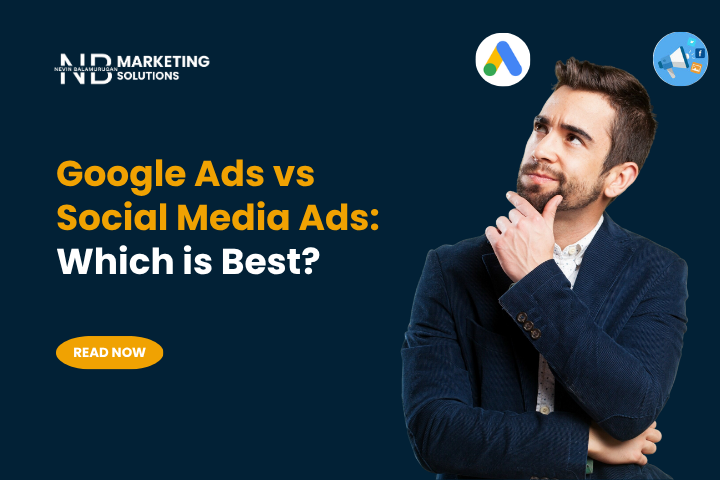Google Ads vs Social Media Ads: Which is Best?
Abirami Dharmalingam
October 3, 2025

Google Ads vs Social Media Ads: A Complete Overview in 2025
If you’re reading this, it’s likely because you’re considering running digital advertising. But one question may cross your mind: “Where do I need to invest – Google Ads vs Social Media Ads?”
Both platforms are powerful, but they work in different ways. In this blog, we’ll cover the pros and cons of each platform, compare how they work, and discuss the factors to consider when deciding which ad platform to use.

Google Ads vs Social Media Ads
Here, we’ll explain about Google Ads vs Social Media Ads in detail, with pros and cons. Without much ado, let’s get started.
What is Google Ads?
You may know that Google is the go-to source for information. Google comes across millions of websites, apps, and other platforms, where you can display your client’s ad. As you already know, Google Ads work on a pay-per-click (PPC) basis, where you bid on keywords and pay when customers click on your ads.
When you advertise on Google Ads, you can appear in front of customers who are actively searching for your niche-related products or services. Search ads and Shopping ads appear in search results based on the keywords your potential customers enter, whereas the other ads can be displayed precisely based on your customer buyer persona.
Now that you have an idea about Google Ads, let us know the pros and cons of using Google Ads for your business.
Pros of Google Ads
Wider reach: Google serves over 16.4 billion searches per day. No matter who your target audience is or which niche they are in, they probably use Google. So, incorporating your ads in Google Ads helps your brand to display across its vast network (search results, websites, apps, YouTube, and Gmail), which helps your client’s brand to reach globally.
Various ad formats: Google Ads has different ad formats that include search ads (text-based), display ads and video ads (visually engaging), and shopping ads (focusing on products). This variety allows you to choose the best format depending on your client’s goals and audience behaviour.
High purchase intent: Customers who search for specific products or services on Google already know what they want. They search for information before they are ready to purchase your brand products. With the knowledge, Google Ads show up at certain times that allow customers to take a specific action. You still need to sell with value, a lot easier to make a decision.
Remarketing: Through this approach, you can re-engage with customers who have already visited your website but didn’t convert. By showcasing your ads regularly, your brand can come to mind to bring them back and make a purchase.
Performance tracking: It equips you to monitor the various metrics, including clicks, conversions, and ROI. This lets you optimize your campaigns, allocate budgets effectively, and continuously improve results.
Location targeting: Whether you’re promoting a small business in one city, Google Ads can make it happen with precision. You can target specific geographic areas (country, region, city, or specific radius) to reach customers based on their location who are interested in it.
Cons of Google Ads
More expensive: You have a higher ad spend and average cost per click (CPC) on Google Ads. Because you can measure your marketing efforts and return on spend (ROAS) more precisely. Plus, it also depends on your competitive keywords (higher volume), which can be costly.
Non-stop updates: Every year, you can see updates and new formats that can be incorporated in Google Ads. This lets you learn a lot about the numerous features and constant updates that require ongoing learning. A new Google Ads Specialist can feel overwhelmed without proper guidance.
More comprehensive to understand: You need to dive deeper into the client’s account. Each of your clients’ campaigns demands a ton of adjustments that can make it difficult to manage. With bidding strategies, audience segments, ad scheduling, performance analysis, and automation can quickly overwhelm the new business owner.

What are Social Media Ads?
Social media advertising is a marketing tactic that can increase brand awareness, drive leads, and boost revenue by placing your ads on social media platforms such as Facebook, Instagram, Twitter, LinkedIn, and other platforms.
You have a variety of ad formats, including images, videos, stories, and carousel posts, making them ideal for brands to connect with customers in a personal and interactive way.
What makes them especially effective is sophisticated targeting. You can segment audiences based on demographics, interests, behaviors, and even custom lookalike audiences to reach a specific audience. Moreover, you can measure your performance through metrics such as clicks, impressions, and conversions.
Pros of Social Media Ads
Quick result: With sponsored posts, you can generate immediate results, such as visibility, traffic, or sales. This benefits your time from promotions and product launches.
Performance tracking capabilities: Social media ads provide comprehensive data to track your customer journey from impression to conversion.
Cost-Effective: Social media advertising is cost-effective than Google Ads, making it attractive for small businesses with smaller budgets. Whether you’re running brand awareness or engagement-focused ads, you can adjust budgets and implement strategies to get the most out of every dollar spent.
Advanced targeting: Sponsored posts offer advanced targeting options to segment your target audience by demographics, interests, online behavior, and custom audiences. This advanced targeting helps your messages reach a relevant audience and improves the efficiency of your ad budget.
Visually appealing: Social media ad formats offer extensive creative options to make your ads visually appealing through images, videos, and carousel elements. This helps your client’s brands to showcase their products or services creatively and engagingly to grab the attention of the customers.
Community building: You can build long-term customer relationships by engaging customers with comments, DMs, and shares. You can build a community for your brand to gain your customers’ trust and loyalty.
Cons of Social Media Ads
Lower intent compared to search ads: Google Ads capture customers actively searching for products or services, while social media ads rely on demographics, interests, and behaviors. This means you’re often reaching people who may not have immediate purchase intent, which makes your conversions more challenging.
Negative feedback management: Negative comments can damage your brand’s reputation. You need an agency or social media team to handle your social media accounts.
Ad Fatigue: When a customer uses social media, feeds may be crowded with ads. Most of the time, customers quickly scroll through the high volume of ads, which can lead to ad fatigue. Overexposure can lead to ad fatigue, decrease engagement rates, and reduce the effectiveness of ad campaigns over time.
When to Use Google Ads vs Meta Ads?
You have seen the pros and cons of Google Ads vs Social Media Ads. Now, let us look into which platform is best for you – it depends greatly upon your business objective.
Use Google Search Ads when:
- You want to capture high-intent customers who are actively searching related to your niche.
- You’re looking for quick results and leads.
- You have a clear understanding of the keywords that your customers use.
- You’re in a highly competitive market.
- You want high return-on-investment (ROI).
- Your business relies on urgent solutions.
Use Social Media Ads when:
- You want to increase brand awareness.
- You have visually appealing content to share (images, videos, carousels of before/after photos, how-to videos or carousels).
- You want to create long-term engagement.
- You want to target specific demographics or interest groups.
- You want to retarget potential customers.
- You want to promote seasonal campaigns, events, or launches
Now it’s purely in your hands, which to choose for your business: Google Ads vs Social Media Ads.
Choose the Right Platform: Google Ads vs Social Media Ads For Your Business
When it comes to digital advertising, the debate between Google Ads and Social Media Ads never comes to an end. Both platforms have unique advantages and can be effective when used strategically. Many businesses find that using both platforms can deliver the best results at every stage of their journey. However, managing campaigns across multiple platforms can be overwhelming.
That’s why reach NB Marketing Solutions, we specialize in helping brands to create campaigns on both platforms. You can handle your business, but we bring customers to your doorstep by developing a strategic advertising plan.
Recent Posts
Have Any Question?
- (+91) 938-542-1049
- info@nbmarketingsolutions.in
Categories
Make Appointment
Confused Over Choosing The Right Services For Your Business?
Tamil Nadu, India
- Near TMB Bank, Anjugramam post, Kanyakumari 629401
- info@nbmarketingsolutions.in
- (+91)93-8542-1049
